Paul Gilster's Blog, page 115
January 5, 2018
2017 from an Interstellar Perspective
The recent burst of interest in interstellar flight has surely been enhanced by the exoplanet discoveries that have become almost daily news. Finding interesting planets, some of them with the potential for water on their surfaces, inevitably raises the question of how we might find a way to get there. We can only imagine this accelerating as missions like the Transiting Exoplanet Survey Satellite (TESS) and the James Webb Space Telescope begin to fill in not just our inventory of nearby planets but our understanding of their compositions.
Find a terrestrial class planet around another star — we may find that there is more than one around the Alpha Centauri stars — and the interstellar probe again becomes a topic of lively conversation. Breakthrough Starshot, the hugely ambitious attempt to develop a concept for tiny payloads being delivered through beamed laser propulsion to a nearby star, is by now a major part of the discussion. And as I said in my closing remarks at the recent Tennessee Valley Interstellar Workshop in Huntsville, there is a synergy among these developments.
Here’s a bit of what I said in Huntsville:
The emergence of Breakthrough Starshot clearly changes the game for everyone in the interstellar community. We have a congressional subcommittee report that ‘encourages NASA to study the feasibility and develop propulsion concepts that could enable an interstellar scientific probe with the capability of achieving a cruise velocity of 10 percent of the speed of light.’ I doubt seriously that that phrasing would have emerged without the powerful incentive of the funding provided by Breakthrough, nor would the Tau Zero Foundation’s recent grant.
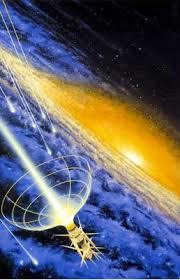
Let’s take this apart and look at the pieces. We all know that Breakthrough Starshot lit up media coverage of the interstellar idea at the same time that we were finding an interesting planet not so much larger than Earth in what appeared to be a habitable zone orbit around Proxima Centauri — being at one of the Breakthrough Starshot sessions when the announcement was made was an energizing experience, and I remember staying up late one night in Palo Alto writing the article on the Proxima Centauri discovery that I would post when the embargo lifted.
Image credit: Manchu.
The subcommittee report I referred to was the work of representative John Culberson (R–TX), long known for his interest in the space program and a panelist at the TVIW 2017 gathering. Culberson submitted a report to the Committee on Appropriations to accompany a bill setting NASA’s budget for the 2017 fiscal year, which began on October 1 of that year.
The bill sets down a futuristic agenda:
Interstellar propulsion research.—Current NASA propulsion investments include advancements in chemical, solar electric, and nuclear thermal propulsion. However, even in their ultimate theoretically achievable implementations, none of these could approach cruise velocities of one-tenth the speed of light (0.1c), nor could any other fission-based approach (including nuclear electric or pulsed fission). The Committee encourages NASA to study and develop propulsion concepts that could enable an interstellar scientific probe with the capability of achieving a cruise velocity of 0.1c.
Part of this study would be focused on Alpha Centauri, as the report makes clear:
These efforts shall be centered on enabling such a mission to Alpha Centauri, which can be launched by the one-hundredth anniversary, 2069, of the Apollo 11 moon landing.
And there is this about propulsion prospects:
Propulsion concepts may include, but are not limited to fusion-based implementations (including antimatter-catalyzed fusion and the Bussard interstellar ramjet); matter-antimatter annihilation reactions; multiple forms of beamed energy approaches; and immense ‘sails’ that intercept solar photons or the solar wind. At the present time, none of these are beyond technology readiness level (TRL) 1 or 2. The NASA Innovative Advanced Concepts (NIAC) program is currently funding concept studies of directed energy propulsion for wafer-sized spacecraft that in principle could achieve velocities exceeding 0.1c and an electric sail that intercepts solar wind protons.
The report notes work at the NASA Innovative Advanced Concepts program, pointing to studies Phil Lubin (UC-Santa Barbara) has performed on the whole issue of beamed propulsion using lasers. This work is repeatedly cited by Breakthrough Starshot and Lubin is actively involved in Breakthrough’s work on laser technologies. Thus there is some overlap even here between NASA and a privately funded venture that is putting the beamed sail idea to the test and examining the infrastructure needed.
What Culberson’s report went on to do was to tell NASA to submit an “interstellar propulsion technology assessment report” with a draft roadmap that could include an overview of the propulsion concepts considered viable, one that would include the technical challenges, assessments of technology readiness levels, near-term goals and funding requirements.
If this sounds familiar, it is because of the tie-in with the grant recently awarded to the Tau Zero Foundation to compile just such a technology roadmap, work which is now in progress. But despite overstatements in many media outlets (along the lines of ‘NASA Planning Interstellar Mission’ and the like), funding breakthrough propulsion ideas is difficult at the best of times, as Tau Zero founder Marc Millis knows all too well. The former head of NASA’s Breakthrough Propulsion Physics project, Millis told me that acquiring the Tau Zero grant was an extended process that took a number of years to complete. From a recent email:
“A part of this story is the funding process. Those processes are not as singular or straight forward (or fast) as many envision. For example, the grant awarded to Tau Zero in January 2017 was proposed to NASA five years earlier, in February 2012. At that time NASA agreed that such work was needed, but was out of scope for its current funding categories. As those five years passed, the details of the work were iterated with NASA four times, each time getting closer to being funded. The last requested revision was December 2016, where Culberson’s interest added the last nudge. The other part of this story is that funding can vanish faster than it is awarded. In multi-year grants, like the one to Tau Zero, there is no guarantee that funding will exist for its second and third years. That is all part of the realities that we have to deal with.”
In other words, although I’ve seen the ‘NASA to the stars’ story pitched as a reprise of the Apollo program, it is actually a very small step in the direction of assessing what would be required to get an interstellar option in motion. This is certainly not a funded effort to build and launch specific hardware, or even a detailed mission study of the sort Breakthrough Starshot will be creating. But we do have recent reports that a small team based at the Jet Propulsion Laboratory is working on further ideas. JPL’s Anthony Freeman spoke of the possibilities at the 2017 American Geophysical Union conference. At the Huntsville TVIW meeting, JPL’s Stacy Weinstein-Weiss discussed the science prospects for an interstellar probe.
Obviously, we’ll follow such efforts with great interest. Meanwhile, my assumption on the background of all this is that Breakthrough Starshot’s sudden emergence prompted questions about NASA’s interest in interstellar matters on the part of Rep. Culberson, who off-loaded the idea to the committee report, which led to the awarding of the Tau Zero grant, perhaps intensifying the JPL investigations as well. A cynic might question whether the whole story hasn’t received far too much attention, given the excesses of many headline writers. But I have a different take.
In my view, keeping deep space in front of the public is helpful as long as we are pointing to legitimate research that moves the ball forward. The idea that NASA has a large interstellar program in place is incorrect, but that it takes even small steps in this direction by way of early conceptualizations and roadmaps is encouraging. Meanwhile, a vigorous private effort to put theoretical technologies to actual prototype and testing is all to the good, perhaps pointing toward future synergies between space agencies and non-traditional space organizations.
Everything gets blown out of proportion somewhere on the Internet, a challenge we all have to live with as we pursue ideas as futuristic as travel to other stars. But on balance, I’d say that 2017’s flurry of media attention was a good thing, and one that may remind us how much it would take to actually build serious interstellar hardware by 2069 or sooner. Technologies need development at every level, but there is nothing wrong with the Starshot model, beginning with conceptual studies and progressing to laboratory work that could point to eventual starflight.






January 4, 2018
3200 Phaethon: Arecibo Back at Work
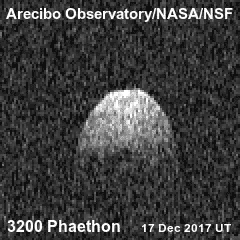
With the holidays behind us (alas), I want to be sure to cover the Arecibo observations of asteroid 3200 Phaethon, not only for their intrinsic interest but as a nod to the restoration of operations at the Puerto Rico observatory. We are fortunate indeed that the structural damage Arecibo suffered on September 20 because of hurricane Maria was relatively minor. Radio astronomy work was back in progress within days of the storm, though it took until early December before commercial power was restored and radar work could resume.
If you’re interested in radar astronomy, have a look at Alessondra Springmann’s How Radar Really Works: The Steps Involved Before Getting an Image, which is available via The Planetary Society. Springmann offers a detailed overview of radar operations with a splash of humor:
Arecibo Observatory is known for its 305-meter (1000-foot) diameter telescope and its appearances in Goldeneye and Contact. Aside from battling Bond villains and driving red diesel Jeeps around the telescope (grousing at the site director about the funding status of projects is optional), several hundred hours a year of telescope time at Arecibo go toward radar studies of asteroids. A group of four planetary radar astronomers at Arecibo (as well as collaborators and colleagues at institutions outside of Puerto Rico) is tasked with “finding them before they find us” by NASA’s Near-Earth Object Observation program. We study the orbits and surface properties of our rowdy neighbors, near-Earth asteroids.
‘Finding them before they find us’ indeed. Arecibo contains the most powerful radar system on the planet, making it a key asset for planetary defense, a great part of which is keeping an eye on asteroids close enough to be problematic. This is a facility we need to keep in action as we continue to build the catalog of near-Earth asteroids and examine their properties. The recently released observations of 3200 Phaethon were conducted from December 15 to 19, 2017.
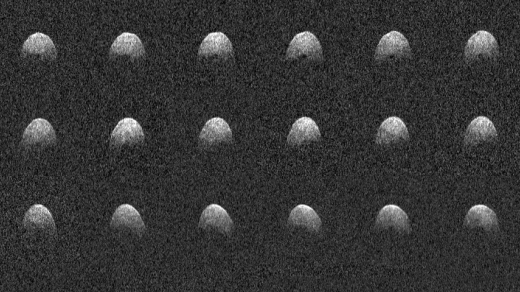
Image: These radar images of near-Earth asteroid 3200 Phaethon were generated by astronomers at the National Science Foundation’s Arecibo Observatory on Dec. 17, 2017. Observations of Phaethon were conducted at Arecibo from Dec.15 through 19, 2017. At time of closest approach on Dec. 16 at 3 p.m. PST (6 p.m. EST, 11 p.m. UTC) the asteroid was about 10.3 million kilometers away, or about 27 times the distance from Earth to the moon. The encounter is the closest the object will come to Earth until 2093. Credit: Arecibo Observatory/NASA/NSF.
About Phaethon itself, we know that it is about 6 kilometers in diameter, larger than previously thought, and is the second largest near-Earth asteroid in the category classified as ‘potentially hazardous.’ Size and close approach are determinants of which asteroid fits into that category, but work on any passing asteroid is useful because radar can study its size, shape, rotation, and surface features, while adding to our knowledge of its trajectory. Joan Schmelz, Arecibo’s deputy director, calls the facility “crucial for planetary defense work,” and that it is.
The images of 3200 Phaethon are the best we’ve yet taken, showing a spheroidal object with a large concave depression near its equator and a dark circular feature near one of its poles. The resolution in these images is about 75 meters per pixel.
“These new observations of Phaethon show it may be similar in shape to asteroid Bennu, the target of NASA’s OSIRIS-REx spacecraft, but more than 1,000 Bennus could fit inside of Phaethon,” said Patrick Taylor, a Universities Space Research Association (USRA), Columbia, Maryland, scientist and group leader for Planetary Radar at Arecibo Observatory. “The dark feature could be a crater or some other topographic depression that did not reflect the radar beam back to Earth.”
This asteroid is, by the way, the first to be discovered through images taken from a spacecraft, the craft in question being the Infrared Astronomical Satellite (IRAS), which produced data that Simon Green (Open University) and John K. Davies (then at Leicester University) examined to find the object. It is the parent body of the Geminids meteor shower and, given over thirty years of observations, is an asteroid with a well determined orbit, one well constrained for the next 400 years. The closest approach to Earth in 2017 was known with an accuracy of ±40 kilometers.






January 3, 2018
KIC 8462852: A Dusty Solution?
Research into Boyajian’s Star, otherwise known as KIC 8462852 or ‘Tabby’s Star,’ has continued in robust fashion even as many of us were distracted by that other curiosity with a faint SETI potential, the interstellar asteroid `Oumuamua. In both cases, a highly interesting object provoked speculation as to its origins, with Boyajian’s Star getting the lion’s share of attention because the unusual dips in its lightcurve proved hard to explain.
Now a team of more than 200 researchers led by Tabetha Boyajian herself is drawing useful conclusions about the star. Also on the team is Penn State’s Jason Wright, whose interest in possible SETI signatures led him to point out that engineering on a vast scale could not immediately be ruled out. The paper now being made available in The Astrophysical Journal Letters shows that the star dims more at some wavelengths than at others.
And that is, to say the least, problematic for the idea that an artificial megastructure orbits Boyajian’s Star. The paper, titled “The First Post-Kepler Brightness Dips of KIC 8462852,” draws on data collected by Boyajian (Louisiana State) and colleagues as a result of a Kickstarter campaign in which some 1700 contributors donated money to observations through the Las Cumbres Observatory, a network of robotic telescopes with northern hemisphere sites in the Canary Islands and Hawaii. Follow-up data were acquired from a number of other instruments.
The observations ran from March 2016 to December 2017, with four main 1–2.5% dips, beginning in May of 2017 and named “Elsie,” “Celeste,” “Skara Brae,” and “Angkor,” persisting on timescales from several days to weeks. What analysis of these dips shows is not consistent with any solid structure around the F3-class Star. As Wright explains on his PSU site:
Eva Bodman has done a lot of work to characterize how much deeper the dips are at blue wavelengths than red ones. If there were opaque objects blocking our view of the light, the star should get equally dim at all wavelengths. Instead, Eva finds that the blue (B) dips are much deeper—about twice as deep—as they are when we look at infrared wavelengths (i’ band, just beyond human vision).
This is consistent with ordinary astrophysical dust, and a major conclusion of our paper: the dips are not caused by opaque macroscopic objects (like megastructures or planets or stars) but by clouds of very small particles of dust (less than 1 micron in typical size). We can also say that these clouds are mostly transparent (“optically thin” in astrophysics parlance).
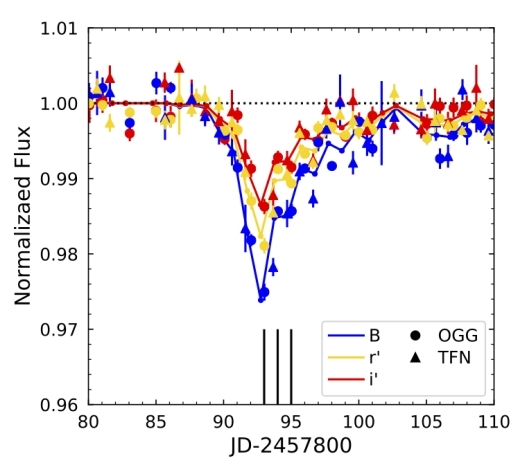
Image: Analysis of LCO data by Eva Bodman.
This work marks the first real-time detection of a dip in brightness for this unusual star, and as the paper notes, “Triggered spectroscopic and polarmetric observations taken during the dips reveal no large, obvious changes compared to out of dip observations.”
The paper goes on to say:
Invoking dust still challenges our creativity in developing a unified theory to explain all the observations; however, the models of Wyatt et al. (2017) give hope to a swarm of yet unspecified objects in an eccentric orbit (in this case, exocomets, with an alternative being dust-enshrouded planetesimals as proposed by Neslušan & Budaj 2017) causing the brightness fluctuations. Continued monitoring to detect events in the future will help narrow down any periodicity within the dip occurrence, which would strengthen the argument that the source of the obscuring material was in orbit around the star, as opposed to density fluctuations in the ISM, etc.
It would have been exciting, to say the least, to find evidence for an artificial cause of Boyajian’s Star’s peculiarities, but I find this work exhilarating in its own right. What we have here is a highly publicized, privately funded investigation into an enigmatic phenomenon that now seems to be closer to a solution. That extraterrestrial engineering is not involved doesn’t diminish the power of the process, in which scientists examined an observational anomaly from all angles and counted an ETI hypothesis among the possibilities.
Bear in mind that using through the Kepler data on Boyajian’s Star alone would not have been sufficient because ground-based follow-up observations were not contemporaneous. That made the ability to summon up a crowd-funded campaign to observe with various instruments at differing sensitivities, resolutions and wavelengths an essential component in this result.
A friend asked not long after the Boyajian’s Star story broke whether I would be disappointed if it turned out to have a ‘boring natural cause.’ But that’s just it. I don’t find natural causes boring, especially when they push us to the limit to explain them. We still have a mystery here, because the original comet hypothesis — or the idea that some kind of circumstellar material is responsible — gains new life at the same time that regular dimming of the star itself — through mechanisms not yet understood — cannot be ruled out. Getting a handle on unusual astrophysical phenomena has a deep allure as we continue to learn about the cosmos.
Where next, then, with Boyajian’s Star? The paper concludes:
We emphasize the importance that continued monitoring will bring to our understanding of the physical processes responsible for the light curve features. In general, precise, long-term photometric monitoring to detect future dips is a level-zero requirement. These data also provide the means of informing planned triggered observations such as high-resolution spectroscopy to study the events in more detail. Furthermore, extended photometric monitoring will enable us to characterize the star’s long-term variability (Schaefer 2016; Montet & Simon 2016; Meng et al. 2017; Simon et al. 2017), which is thought to be linked to the dips in some way. All-in-all, the apparent low duty cycle of the dips, unclear predictions on when they will recur, and fairly unconstrained multiyear timescales of the long-term variability will require a committed, intensive monitoring program spanning the next decade and beyond.
The paper is Boyajian et al., “The First Post-Kepler Brightness Dips of KIC 8462852,” Astrophysical Journal Letters 2018 January 3 (preprint).






December 29, 2017
The Plasma Magnet Drive: A Simple, Cheap Drive for the Solar System and Beyond
Can we use the outflow of particles from the Sun to drive spacecraft, helping us build the Solar System infrastructure we’ll one day use as the base for deeper journeys into the cosmos? Jeff Greason, chairman of the board of the Tau Zero Foundation, presented his take on the idea at the recent Tennessee Valley Interstellar Workshop. The concept captured the attention of Centauri Dreams regular Alex Tolley, who here analyzes the notion, explains its differences from the conventional magnetic sail, and explores the implications of its development. Alex is co-author (with Brian McConnell) of A Design for a Reusable Water-Based Spacecraft Known as the Spacecoach (Springer, 2016), focusing on a new technology for Solar System expansion. A lecturer in biology at the University of California, he now takes us into a different propulsion strategy, one that could be an enabler for human missions near and far.
by Alex Tolley

Suppose I told you that a device you could make yourself would be a more energy efficient space drive than an ion engine with a far better thrust to weight ratio? Fantasy? No!
Such a drive exists. Called the plasma magnet, it is a development of the magnetic sail but with orders of magnitude less mass and a performance that offers, with constant supplied power, constant acceleration regardless of its distance from the sun.
At the recent Tennessee Valley Interstellar Workshop (TVIW), Jeff Greason presented this technology in his talk [1]. What caught my attention was the simplicity of this technology for propulsion, with a performance that exceeded more complex low thrust systems like ion engines and solar sails.
What is a plasma magnet?
The plasma magnet is a type of magsail that creates a kilometers wide, artificial magnetosphere that deflects the charged solar wind to provide thrust.
Unlike a classic magsail [9] (figure 1) that generates the magnetic field with a large diameter electrical circuit, the plasma magnet replaces the circular superconducting coil by inducing the current flow with the charged particles of the solar wind. It is an upgraded development of Robert Winglee’s Mini-Magnetospheric Plasma Propulsion (M2P2) [7, 8], a drive that required injection of charged particles to generate the magnetosphere. The plasma magnet requires no such injection of particles and is therefore potentially propellantless.
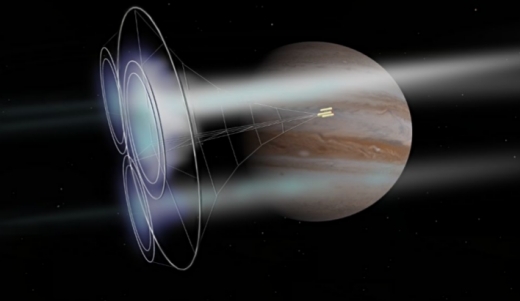
Figure 1. A triple loop magsail is accelerated near Jupiter. Three separate boost beams transfer momentum to the rig, carefully avoiding the spacecraft itself, which is attached to the drive sail by a tether. Artwork: Steve Bowers, Orion’s Arm.
Developed by John Slough and others [5, 6], the plasma magnet drive has been validated by experimental results in a vacuum chamber and was a NIAC phase 1 project in the mid-2000s [6]. The drive works by initially creating a rotating magnetic field that in turns traps and entrains the charged solar wind to create a large diameter ring current, inducing a large scale magnetosphere. The drive coils of the reference design are small, about 10 centimeters in diameter. With 10 kW of electric power, the magnetosphere expands to about 30 kilometers in diameter at 1 AU, with enough magnetic force to deflect the solar wind pressure of about 1 nPa (1 nN/m2) which produces a thrust in the direction of the wind of about 1 newton (1N). Thrust is transmitted to the device by the magnetic fields, just as with the coupling of rotation in an electric motor (figure 2).
For a fixed system, the size of the induced magnetosphere depends on the local solar wind pressure. The magnetosphere expands in size as the solar wind density decreases further from the sun. This is similar to the effect of Janhunen’s electric sail [2] where the deflection area around the charged conducting wires increases as the solar wind density decreases. The plasma magnet’s thrust is the force of the solar wind pushing against the magnetosphere as it is deflected around it. It functions like a square-rigged sail running before the wind.
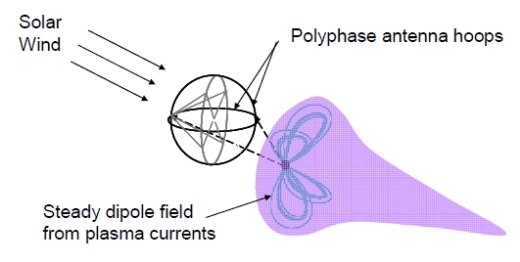
Figure 2. Plasma magnetic sail based on rotating magnetic field generated plasma currents. Two polyphase magnetic coils (stator) are used to drive steady ring currents in the local plasma (rotor) creating an expanding magnetized bubble. The expansion is halted by solar wind pressure in balance with the magnetic pressure from the driven currents (R >= 10 km). The antennas (radius ~ 0.1 m) are shown expanded for clarity. [6]
The engine is little more than 2 pairs of charged rotating coils and is therefore extremely simple and inexpensive. The mass of the reference engine is about 10 kg. Table 1 shows that the plasma magnet has an order higher thrust to weight ratio than an ion engine and 2 orders better than a solar sail. However, as the plasma magnet requires a power source, like the ion engine, the comparison to the solar sail should be made when the power supply is added, reducing is performance to a 10-fold improvement. [ A solar PV array of contemporary technology requires about 10 kg/kW, so the appropriate thrust/mass ratio of the plasma magnet is about 1 order of magnitude better than a solar sail at 1 AU]
The plasma magnet drive offers a “ridiculously high” thrust to weight ratio
The plasma magnet, as a space drive, has much better thrust to weight ratio than even the new X-3 Hall Effect ion engine currently in development. This ratio remains high when the power supply from solar array is added. Of more importance is that the plasma magnet is theoretically propellantless, providing thrust as long as the solar wind is flowing past the craft and power is supplied.
NameTypeThrust/weight (N/kg)
Engine mass onlyThrust/weight (N/kg) with power supply
SSMEChemical717N/A
RD-180Chemical769N/A
plasma magnetosphereElectro-magnetic0.1.01
NSTAR-1Ion (Gridded)0.0040.002
X-3Ion (Hall Effect)0.020.004
Solar SailPhoton Sail0.001 (at 1 AU)N/A
Table 1. Comparison of thrust to mass ratios of various types of propulsion systems. The power supply is assumed to be solar array with a 10 kg/kW performance.
The downside with the plasma magnet is that it can only produce thrust in the direction of the solar wind, away from the sun, and therefore can only climb up the gravity well. Unlike other propulsion systems, there is little capability to sail against the sun. While solar sails can tack by directing thrust against the orbital direction, allowing a return trajectory, this is not possible with the basic plasma magnet, requiring other propulsion systems for return trips.
Plasma magnet applications
1. Propulsion Assist
The most obvious use of the plasma magnet that can only be used to spiral out from the sun is as a propellantless assist. The drive is lightweight and inexpensive, and because it is propellantless, it can make a useful drive for small space probes. Because the drive creates a kilometers sized magnetosphere, scaling up the thrust involves increased power or using multiple drives that would need to be kept 10s of kilometers apart. Figure 3 shows a hypothetical gridded array. Alternatively, the plasma magnets might be separated by thrusters and individually attached to the payload by tethers.
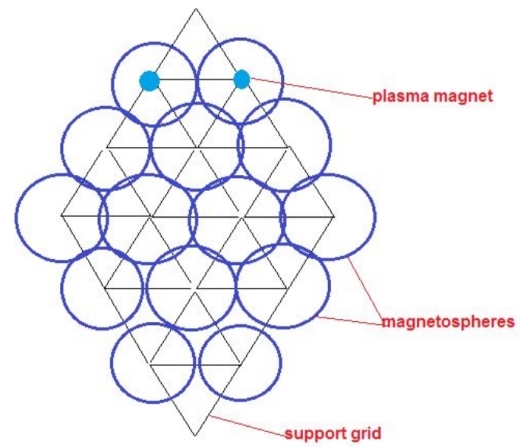
Figure 3. Plasma magnets attached to the nodes in a 2D grid could be used to scale up the thrust. The spacecraft would be attached by shroud lines as in a solar sail with a trailing payload. Scaling up the power supply to create a larger magnetosphere is also possible.
For a mixed mode mission, the plasma magnet engine is turned on for the outward bound flight, with or without the main propulsion system turned on. The use of power to generate thrust without propellant improves the performance of propellant propulsion systems where the accumulated velocity exceeds the performance cost of the power supply mass or reduced propellant. For an ion engine as the main drive, the plasma magnet would use the same power as 4 NSTAR ion engines but provide 3x the thrust.
2. Moving Asteroids for Planetary Defense
The propellantless nature of the plasma magnet drive makes it very suitable for pushing asteroids for planetary defense. Once turned on, the drive provides steady thrust to the asteroid, propelling it away from the sun and raising its orbit. Because the drive does not need to be facing any particular direction, it can be attached to a tumbling asteroid without any impact on the thrust direction.
3. Charged particle radiation shield for crewed flights
The magnetosphere generated by the engine makes a good radiation shield for the charged particles of the solar wind. It should prove to be a good solution for the solar wind, solar flares and even coronal mass ejections (CME). This device could, therefore, be used for human flight to reduce radiation effects. For human crewed flights, the 1N of thrust is insufficient for the size of the spacecraft and would have a marginal propulsion compared to the main engines. Given the plasma magnet’s small size and mass, and relatively low power requirements, the device provides a cost-effective means to protect the crew without resorting to large masses of physical shielding. The plasma magnet would appear to be only effective for the charged solar wind, leaving the neutral GCRs to enter the craft. However, when an auxiliary device is used in the mode of aerobraking, the charge exchange mechanism should reduce the galactic cosmic ray (GCR) penetration (see item 8 below).
4. Asteroid mining
The plasma magnet thruster might be a very useful part of a hybrid solution for automated mining craft. The hybrid propulsion would ally the plasma magnet thruster with a propellant system, such as a chemical or ion engine. The outward bound trip would use the plasma magnet thruster to reach the target asteroid. The propellant tanks would be empty saving mass and therefore improving performance. The propellant tanks would be filled with the appropriate resource, e.g. water for an electrothermal engine, or for a L2/O2 chemical engine. This engine would be turned on for the return trip towards the inner system. The reverse would be used for outward bound trips to the inner system
5. Interstellar precursor using nuclear power
A key feature of the plasma magnet is that the diameter of the magnetosphere increases as the density of the solar wind decreases as it expands away from the sun. The resulting expansion exactly matches the decrease in density, ensuring constant thrust. Therefore the plasma magnet has a constant acceleration irrespective of its position in the solar system.
As the solar wind operates out to the heliopause, about 80 AU from the sun, the acceleration from a nuclear powered craft is constant and the craft continues to accelerate without the tyranny of the rocket equation. Assuming a craft with an all up mass of 1 MT (700 kg nuclear power unit, 10 kg engine, and the remaining in payload), the terminal velocity at the heliopause is 150 km/s. The flight time is 4.75 years, which is a considerably faster flight time than the New Horizons and Voyager probes.
Slough assumed a solar array power supply, functional out to the orbit of Jupiter at 5 AU. This limited the velocity of the drive, although the electrical power output of a solar array at 1 AU is about 10-fold better than a nuclear power source, but rapidly decreases with distance from the sun. Assuming a 10 kW PV array, generating decreasing power out to Jupiter, the final velocity of the 1 MT craft is somewhere between 5 and 10 km/s, but with a much larger payload.
In his TVIW talk [1], Greason suggested that the 10kW power supply could propel a 2500 kg craft with an acceleration of 0.5g, reaching 400-700 km/s in just half a day. Greason [i] suggested that with this acceleration, the FOCAL mission for gravitational lens telescopes requiring many craft should be achievable. *
6. Mars Cycler
Greason suggested that the plasma magnet might well be useful for a Mars cycler, as the small delta v impulse needed for each trip could be easily met.[1]
7. Deceleration at target star for interstellar flight
For interstellar flights, deploying the plasma magnet as the craft approaches the target star should be enough to decelerate the craft to allow loitering in the system, rather than a fast flyby. Again, the high performance and modest mass and power requirements might make this a good way to decelerate a fast interstellar craft, like a laser propelled photon sail.[1]
8. Magnetoshell Aerocapture (MAC)
While the studies on the plasma magnet seemed to have stalled by the late 2000s, a very similar technology development was gaining attention. A simple dipole magnet magnetosphere can be used as a very effective aerocapture shield. The shield is just the plasma magnet with coils that do not rotate, creating a magnetosphere of a diameter in meters, one that requires the injection of gram quantities of plasma to be trapped in the magnetic field. As the magnetosphere impacts the atmosphere, the neutral atmosphere molecules are trapped by charge exchange. The stopping power is on the order of kilonewtons, allowing the craft to achieve orbit and even land without a heavy, physical shield. The saving in mass and hence propellant is enormous. Such aerobraking allows larger payloads, or alternatively faster transit times. Because the magnetoshell is immaterial, heat transmission to the shield is not an issue. The mass saving is considerable and offers a very cost-effective approach for any craft to reduce mass, propellant requirements or increase payloads. This approach is suitable for Earth return, Mars, outer planets, and Venus capture. Conceivably aerocapture might be possible with Pluto.
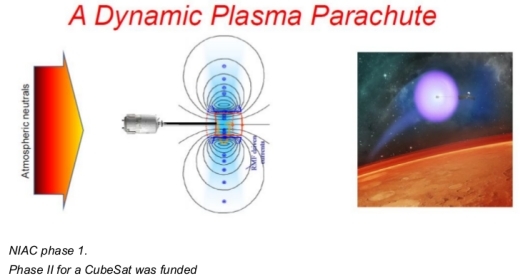
Figure 4. A dipole magnet creating a small diameter magnetic field is injected with plasma. As the magnetosphere impacts the atmosphere, charge exchange result in kilonewton braking forces. The diagram at left shows the craft with the training magnetosphere impacting the atmosphere. The painting on the right shows what such a craft might look like during an aerobraking maneuver. Source: Kirtley et al [3].
Making the plasma magnet thrust directional
A single magnetosphere cannot deflect the solar wind in any significant directional way, which limits this drive’s navigational capability. However, if the magnetosphere could be shaped so that its surface could result in an asymmetric deflection, it should be possible to use the drive for tacking back to the inner system.
Figure 5 shows an array of plasma magnets orientated at an angle to the solar wind. The deflection of the solar wind is no longer symmetric, with the main flow across the forward face of the array. Under those conditions, there should be a net force against the grid. This suggests that like a solar sail, orientating the grid so that the force retards the orbital velocity, the craft should be able to spiral down towards the Sun, offering the possibility of a drive that could navigate the solar system.
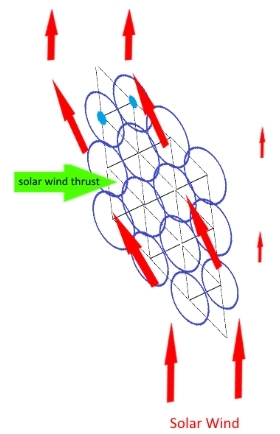
Figure 5. A grid of plasma magnets deflects the flow of the solar wind, creating a force with a component that pushes against the grid. If the grid is in orbit with a velocity from right to left, the force will reduce the grid’s velocity and result in a spiral towards the Sun.
Pushing the Boundaries
The size of the magnetic sail can be increased with higher power inputs, or increasing the antenna size. Optimization will depend on the size of the craft and the mass of the antenna. Truly powerful drives can be considered. Greason [12] has calculated that a 2 MT craft, using a superconducting antenna with a radius of 30 meters, fed with a peak current of 90 kA, would have a useful sail with a radius of 1130 km and an acceleration of 2 m/s2, or about 0.2g. As the sail has a maximum velocity of that of the solar wind, a probe accelerating at 0.2g would reach maximum velocity in a few days, and pass by Mars within a week. To reach a velocity of 20 km/s, faster than New Horizons, the Plasma magnet would only need to be turned on for a few hours. Clearly, the scope for using this drive to accelerate probes and even crewed ships is quite exciting.
Coupling a more modest velocity of just 10’s of km/s with the function of a MAC, a craft could reach Mars in less than 2 months and aerobrake to reach orbit and even descend to the surface. All this without propellant and a very modest solar array for a power supply.
An Asteroid, a tether and a Round Trip Flight
As we’ve seen, the plasma magnet can only propel a craft downwind from the Sun. So far I have postulated that aerobraking and conventional drives would be needed for return flights. One outlandish possibility for use in asteroid mining might be the use of a tether to redirect the craft. On the outward bound flight, the craft driven by the plasma magnet makes a rapid approach to the target asteroid which is being mined. The mined resources are attached to a tether that is anchored to the asteroid. As the craft approaches, it captures the end of the tether to acquire the new payload, and is swung around the asteroid. On the opposite side of the asteroid, the tether is released and the craft is now traveling back towards the Sun. No propellant needed, although the tether might cause some consternation as it wraps itself around the asteroid.
Conclusion
The plasma magnet as a propulsion device, and the same hardware applied for aerocapture, would drastically reduce the costs and propellant requirements for a variety of missions. Coupled with another drive such as an ion engine, a craft could reach a target body with an atmosphere and be injected into orbit with almost no propellant mass. The return journey would require an engine delivering just enough delta V to escape that body and return to Earth, where aerocapture again would allow injection into Earth orbit with no extra propellant. If direction deflection can be achieved, then the plasma magnet might be used to navigate the Solar System more like a solar sail, but with a far higher performance, and far easier deployment.
Using a steady, nuclear power or beamed power source, such a craft could accelerate to the heliopause, allowing interstellar precursor missions, such as Kuiper belt exploration and the FOCAL mission within a short time frame.
The technology of the plasma magnet combined with a MAC could be used to decelerate a slowish interstellar ship and allow it to achieve orbit and even land on a promising exoplanet.
The size of the magnetic sail can be extended with few constraints, allowing for considerably increased thrust that can be applied to robotic probes and crewed spacecraft. For crewed craft, the magnetosphere also provides protection from the particle radiation from the sun, and possibly galactic cosmic rays.
Given the potential of this drive and relatively trivial cost, it seems that testing such a device in space should perhaps be attempted. Can a NewSpace billionaire be enticed?
* These numbers are far higher than those provided by Winglee and Slough in their papers and so I have used their much more conservative values for all my calculations.
References
Greason, Jeff “Missions Enabled by plasma magnet Sails”, Presentation at the Tennessee Valley Interstellar Workshop, 2017. https://www.youtube.com/watch?v=0vVOtrAnIxM
Janhunen, P., The electric sail – a new propulsion method which may enable fast missions to the outer solar system, J. British Interpl. Soc., 61, 8, 322-325, 2008.
Kelly, Charles and Shimazu, Akihisa “Revolutionizing Orbit Insertion with Active Magnetoshell Aerocapture,” University of Washington, Seattle, WA, 98195, USA.
Kirtley, David, Slough, John, and Pancotti, Anthony “Magnetoshells Plasma Aerocapture for Manned Missions and Planetary Deep Space Orbiters”, NIAC Spring Symposium, Chicago, Il., March 12, 2013
Slough, John. “The plasma magnet for Sailing the Solar Wind.” AIP Conference Proceedings, 2005, doi:10.1063/1.1867244.
Slough, John “The plasma magnet” (2006). NASA Institute for Advanced Concepts Phase 1 Final Report.
Winglee, Robert. “Mini-Magnetospheric Plasma Propulsion (M2P2): High Speed Propulsion Sailing the Solar Wind.” AIP Conference Proceedings, 2000, doi:10.1063/1.1290892.
Winglee, R. M., et al. “Mini-Magnetospheric Plasma Propulsion: Tapping the Energy of the Solar Wind for Spacecraft Propulsion.” Journal of Geophysical Research: Space Physics, vol. 105, no. A9, Jan. 2000, pp. 21067–21077., doi:10.1029/1999ja000334.
Zubrin, Robert, and Dana Andrews. “Magnetic Sails and Interplanetary Travel.” 25th Joint Propulsion Conference, Dec. 1989, doi:10.2514/6.1989-2441.
Greason, Jeff. Personal communication.






December 28, 2017
Solar System Formation near a Massive Star
An unusual type of star may be showing us something about the origin of our own Solar System. Wolf-Rayet stars display unusual spectra, prominent in which are heavy elements as well as broad emission lines of ionized helium, nitrogen and carbon. These are massive objects 40 to 50 times the size of our Sun, with surface temperatures ranging up to 200,000 K. Have a look at one of these, showing another Wolf-Rayet trait, the strong stellar winds ejecting material into nearby space. A bubble with a dense shell forms around such stars, trapping gas and dust that could form into new stars.
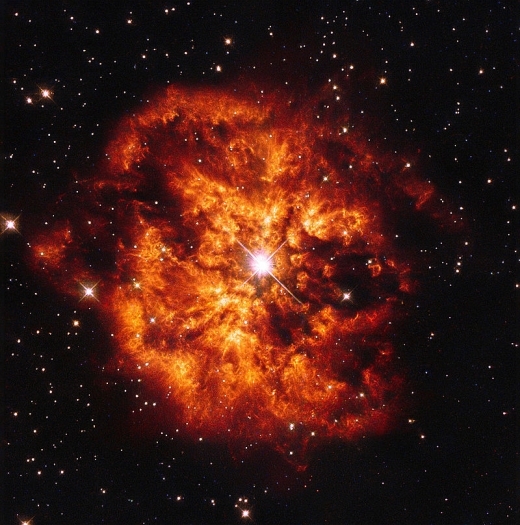
Image: Here we see the spectacular cosmic pairing of the star Hen 2-427 — more commonly known as WR 124 — and the nebula M1-67 which surrounds it. Both objects, captured here by the NASA/ESA Hubble Space Telescope, are found in the constellation of Sagittarius and lie 15,000 light-years away. The star Hen 2-427 shines brightly at the very centre of this explosive image and around the hot clumps of gas that are ejected into space at over 150,000 kilometres per hour. Hen 2-427 is a Wolf–Rayet star, named after the astronomers Charles Wolf and Georges Rayet. Wolf–Rayet are super-hot stars characterized by a fierce ejection of mass. The nebula M1-67 is estimated to be no more than 10,000 years old — just a baby in astronomical terms — but what a beautiful and magnificent sight it makes. A version of this image was released in 1998, but has now been re-reduced with the latest software. Credit: ESA/Hubble.
Vikram Dwarkadas (University of Chicago) and colleagues believe that Wolf-Rayet stars can unlock the mystery of how our Solar System emerged. The researchers are hoping to update the older view that our system formed in the vicinity of a relatively conventional supernova, noting peculiarities in the proportion of two isotopes in the early Solar System. One of these is aluminium-26, which turns up in relatively high proportion in our system compared with the rest of the galaxy.
The other issue is with iron-60, which earlier work by Nicolas Dauphas, a co-author on the current paper, suggests is found in smaller amounts than we would expect. We couple this with the interesting fact that Wolf-Rayet stars release a good deal of aluminium-26, but are not associated with iron-60. Add into the mix the giant stars’ ability to shed mass through intense stellar winds. We wind up with a bubble structure with a dense shell, a potential star-making factory. Dwarkadas and team estimate that 1 to 16% of Sun-like stars could form in this way.
Image: This simulation shows how bubbles form over the course of 4.7 million years from the intense stellar winds off a massive star. UChicago scientists postulated how our own Solar System could have formed in the dense shell of such a bubble. Credit: V. Dwarkadas & D. Rosenberg.
It’s an interesting explanation because we would expect both isotopes to be produced in the kind of supernova long held to have provided materials for the infant Solar System. Given the proportions we actually find in meteorites from the early system, the question becomes why one isotope is found in the days of system formation while the other was not. Says Dwarkadas:
“The idea is that aluminum-26 flung from the Wolf-Rayet star is carried outwards on grains of dust formed around the star. These grains have enough momentum to punch through one side of the shell, where they are mostly destroyed—trapping the aluminum inside the shell.”
Over time, the shell begins to collapse inward due to gravity, forming our Solar System. The original Wolf-Rayet star is long gone, doubtless through a supernova explosion or, the authors note, through direct collapse into a black hole. The latter would produce little iron-60, while the former could have trapped any iron-60 formed in the supernova within the bubble walls.

Image: Slices of a simulation showing how bubbles around a massive star evolve over the course of millions of years (moving clockwise from top left). Credit: V. Dwarkadas & D. Rosenberg.
The paper is Dwarkadas et al., “Triggered Star Formation inside the Shell of a Wolf–Rayet Bubble as the Origin of the Solar System,” Astrophysical Journal Vol. 851, No. 2 (22 December 2017). Abstract available. The earlier paper on iron-60 is Tang & Dauphas, “Low 60FE Abundance in Semarkona and Sahara 99555,” Astrophysical Journal Vol. 802, No. 1 (17 March 2015). Abstract available.






December 27, 2017
Dragonfly: Contemplating a Return to Titan
Our continuing interest in Titan as a possible venue for life was energized last year with the publication of a paper by Martin Rahm and Jonathan Lunine, working with colleagues David Usher and David Shalloway (all at Cornell University). I’ve written about this one before (see Prebiotic Chemistry on Titan?) and won’t revisit the details, but the gist is that hydrogen cyanide produced in Titan’s atmosphere can condense into aerosols that are transformed into interesting polymers on the surface. Of these, the most intriguing seems to be polyimine.

The authors see polyimine as capable of producing complex, ordered structures that absorb light, producing energy that can be used to catalyze prebiotic chemistry. Rather than looking in Titan’s seas, the authors think we’ll find hydrogen cyanide reactions in tidal pools on the shores near seas and lakes. It’s an interesting proposition, and like so many notions about Titan, it requires us to get a payload back to the surface, as we did in 2005 with Huygens. But this time, we’ll want to have extended survivability on Titan and a full suite of instruments.
Image: This composite was produced from images returned on 14 January 2005, by ESA’s Huygens probe during its successful descent to land on Titan. It shows the boundary between the lighter-coloured uplifted terrain, marked with what appear to be drainage channels, and darker lower areas. These images were taken from an altitude of about 8 kilometres with a resolution of about 20 metres per pixel. Credits: ESA/NASA/JPL/University of Arizona.
Thus the news that Dragonfly has won approval as a finalist concept for a robotic launch to Titan in the mid-2020s is encouraging. Dragonfly offers not just a useful instrument package but mobility on the surface in the form of a rotorcraft that could explore numerous sites on the moon. We have to be creative indeed in imagining life that would exist at -180 degrees Celsius in an environment that gets a tenth of one percent of the sunlight Earth’s surface receives. But as Rahm, Lunine and colleagues have reminded us, mechanisms may exist to make it happen.
Elizabeth Turtle (JHU/APL) is lead investigator on Dragonfly, with APL providing project management. The concept involves an eight-bladed drone — two rotors at each of its four corners — capable of sampling widely. Dragonfly would be able to look at prebiotic chemistry of the kind Rahm and Lunine have studied, selecting sites with varying geology and surface composition.
Another key issue for the lander: Is there exchange of organics between the surface and Titan’s interior ocean? Using a Multi-mission Radioisotope Thermoelectric Generator (MMRTG) for power, Dragonfly should be capable of remaining operational not just for months but for years in answering these questions.
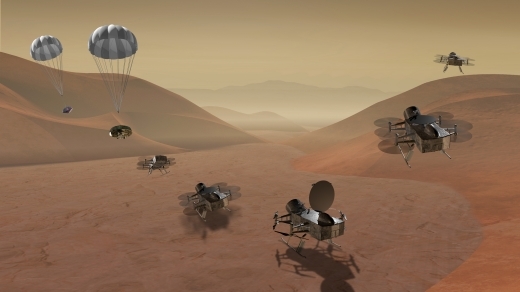
Image: Dragonfly is a dual-quadcopter lander that would take advantage of the environment on Titan to fly to multiple locations, some hundreds of kilometers apart, to sample materials and determine surface composition to investigate Titan’s organic chemistry and habitability, monitor atmospheric and surface conditions, image landforms to investigate geological processes, and perform seismic studies. Credit: NASA.
NASA’s competitive peer review process whittled a dozen proposals submitted under the New Frontiers program announcement of opportunity down to a final two, the other being a Comet Astrobiology Exploration Sample Return (CAESAR). Here we’re talking about a return to 67P/Churyumov-Gerasimenko, following up the European Space Agency’s highly successful Rosetta mission. Both CAESAR and Dragonfly will receive funding through the end of 2018. One of the concepts will be selected the following year for subsequent mission phases.
Expect more on CAESAR in an upcoming article. The Rahm et al. paper mentioned above is “Polymorphism and electronic structure of polyimine and its potential significance for prebiotic chemistry on Titan,” published online by Proceedings of the National Academy of Sciences 4 July 2016 (full text). Matt Williams interviews Elizabeth Turtle about Dragonfly in a fine Universe Today article from May of this year.






December 20, 2017
A Pulsar Habitable Zone?
Life and pulsars don’t seem to mix. But science fiction hasn’t shied away from making the connection, as witness Robert Forward’s Dragon’s Egg (Ballantine, 1980). In the novel, a species called the cheela live on the surface of a neutron star, coping with a surface gravity 67 billion times stronger than that of Earth. An interesting consequence: The cheela live at an accelerated rate, going from the development of agriculture to high-tech in little more than a month, as perceived by the human crew observing the course of their rapid development.
Now we have news that two astronomers are considering habitable planets in orbits around pulsars, a venue that to my knowledge Forward never considered, but perhaps more recent science fiction writers have (let me know if you have any references). Alessandro Patruno (Leiden University), working with Mihkel Kama (Leiden and Cambridge University) see reasons for thinking that life might emerge in such an environment, though the kind of atmosphere that would sustain it would be like nothing we’ve yet encountered.
The paper defines three categories of neutron star planets while explaining the conditions they would be subjected to:
Neutron star planets can be first-, second- or third-generation. First generation planets would be formed in the usual manner, as a by-product of the star formation process, and would likely be ablated or unbound during stellar death. Second generation objects would form in the supernova fallback disk around a freshly-formed neutron star. Third generation planets would form from a disk consisting of a disrupted binary companion (possibly previously overflowing its Roche lobe), thought to be essential for producing millisecond pulsars such as B1257+12. The supernova explosion, the accretion from a companion for millions up to billion years that MSPs [millisecond radio pulsars] undergo, and the emission of high energy X-ray/γ-ray radiation and MeV–TeV particles (the pulsar wind) are all disruptive processes that might destroy planets or disrupt their orbits.
In any case, neutron stars deal out bursts of X-rays and other particles, accreting matter around them and boasting huge magnetic fields. This is a very dicey environment, one would think, to be talking in terms of habitable zones. But in their paper in Astronomy & Astrophysics, Patruno and Kama find room for a habitable zone as large as 1 AU in breadth. To make this work, the planet must be a super-Earth with a mass between one and ten times that of Earth. Also required: An atmosphere a million times as thick as Earth’s.
Daunting conditions indeed. The work draws on studies of the pulsar PSR B1257+12, famous for its three known planets, which were the first exoplanets ever discovered, in 1992 (the third was found in 1994, still a year before the discovery of 51 Pegasi b). Aleksander Wolszczan and Dale Frail will forever be associated with the discovery. Patruno and Kama used the Chandra space telescope to study PSR B1257+12, which is 2300 light years out in Virgo.
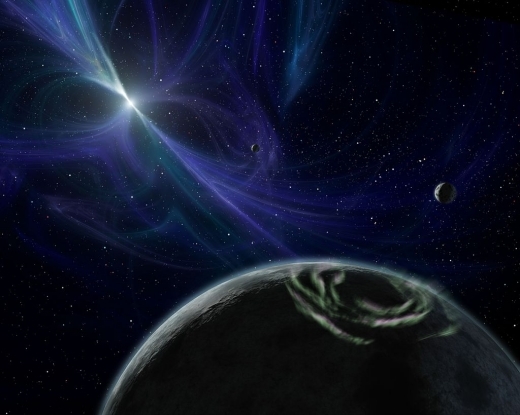
Image: This artist’s concept depicts the pulsar planet system discovered by Aleksander Wolszczan in 1992. Wolszczan used the Arecibo radio telescope in Puerto Rico to find three planets – the first of any kind ever found outside our solar system – circling a pulsar called PSR B1257+12. Pulsars are rapidly rotating neutron stars, which are the collapsed cores of exploded massive stars. They spin and pulse with radiation, much like a lighthouse beacon. Here, the pulsar’s twisted magnetic fields are highlighted by the blue glow. All three pulsar planets are shown in this picture; the farthest two from the pulsar (closest in this view) are about the size of Earth. Radiation from charged pulsar particles would probably rain down on the planets, causing their night skies to light up with auroras similar to our Northern Lights. One such aurora is illustrated on the planet at the bottom of the picture. Credit: NASA/JPL-Caltech/R. Hurt (SSC).
What we have around this pulsar are two super-Earths with masses between 4 and 5 times that of Earth, orbiting the pulsar at 0.36 and 0.46 AU respectively; the third, innermost planet is about twice as massive as the Moon. The pulsar itself shows a mass of 1.4 times the Sun’s, with a radius estimated to be in the range of 10 kilometers. All three planets are close enough to be heated by the pulsar, a daunting thought given the X-ray radiation and relativistic ‘pulsar wind,’ which could have devastating effects on a planetary atmosphere.
Nonetheless, the paper continues:
… the two Super-Earths may have retained their atmosphere for at least a hundred million years provided they contain a large atmospheric fraction of the total planet mass, with the atmosphere possibly still being present to these days. We also find that if a moderately strong planetary magnetosphere is present, the atmospheres can survive the strong pulsar winds and reach survival timescales of several billion years. The same argument applies to possible pulsar planets around more powerful objects than PSR B1257+12.
We are talking about a planet that would have an atmosphere accounting for about 30 percent of the planet’s mass. In this news release, the authors liken conditions on the surface of such a world to the deep sea floor here on Earth. Says Patruno: “According to our calculations, the temperature of the planets might be suitable for the presence of liquid water on their surface. Though, we don’t know yet if the two super-Earths have the right, extremely dense atmosphere.”
That pulsar wind remains tricky on several levels. It is not an indefinite process, but one that turns off once the pulsar reaches a slow enough rate of spin. The paper points out that young pulsars turn off the pulsar wind within about a million years, while millisecond radio pulsars do the same in about a billion years. Losing the pulsar wind turns off the planet’s energy source and would cause a dramatic drop in temperature, unless tidal heating, radiogenic effects or X-ray radiation can step in in a process called Bondi-Hoyle accretion, analyzed in the paper:
Isolated neutron stars are directly exposed to the interstellar medium and it is expected that all of them would accrete some of this material. Such accretion process generates extra power due to the conversion of the accreted gas rest mass into energy, with a typical efficiency of the order of 10–20%. This so-called Bondi-Hoyle accretion process should be continuous and might be the main source of power for these type of systems.
I’m thinking science fiction writers among our audience (of which there are more than a few) might want to look at this paper to see what kind of scenarios they can tease out of it. Bear in mind that to this date, we’ve found but five pulsar planets, out of some 3000 pulsars studied. But exotica are what science fiction thrives on, and the kind of habitable zone depicted here is made to order for the hard science fiction writer willing to dig into this paper’s equations.
Addendum: Didn’t Alastair Reynolds deal with a neutron star planet in the first book of the Revelation Space sequence? I need to revisit the series. Wonderful stuff.
The paper is Patruno & Kama, “Neutron Star Planets: Atmospheric Processes and Irradiation,” Astronomy & Astrophysics Vol. 608, A147, published online 19 December 2017 (full text).






December 19, 2017
What We Can Rule Out at Alpha Centauri
One of the reasons to pay attention to spectrograph technologies — and we recently talked about ESPRESSO, which has just achieved ‘first light’ — is that we’re reaching the inflection point when it comes to certain key observations. Finding planets around Centauri A and B has been the gold standard for a number of researchers, and as Debra Fischer (Yale University) points out, we’re just now getting to where spectrographic technology is up to the challenge.
Chile is where much of the action is. Here we find ESPRESSO installed on the European Southern Observatory’s Very Large Telescope at Paranal. But Fischer’s team has built CHIRON at Cerro Tololo, and the paper likewise relies on data from the Geneva team’s HARPS and the UVES installation at the Very Large Telescope Array in the United States. Working with Yale’s Lily Zhao, Fischer has re-examined older data with an eye toward turning once again to Centauri A and B with a new round of observations beginning the year after next.
The scientist seems quite optimistic, and not just about the technology. In a Yale University news release she says: “Because Alpha Centauri is so close, it is our first stop outside our solar system. There’s almost certain to be small, rocky planets around Alpha Centauri A and B.”
Let’s dig into that assertion a bit. We’ve proceeded at Centauri A and B just as we did at Proxima Centauri, beginning with observations that allowed us to drill down progressively into the possible planet populations there. For a long time, it has been possible to say that no super-Earths larger than 8.5 Earth masses could be detected around Proxima in orbits with a period of 100 days (this was from work by Michael Endl and Martin Kürster). The same work showed that no super-Earths of 2-3 Earth masses could be found in the Proxima habitable zone.
But by pushing to ever more exacting observations, Guillem Anglada‐Escudé and team eventually discovered Proxima Centauri b, and now we are on the hunt for further planets there. In the close binary Centauri A and B system, Debra Fischer’s team can do something similar. Their new paper, looking at possibilities in the respective stars’ habitable zones, finds no evidence for planets at Centauri A larger than about 50 Earth masses. At Centauri B, we find no planets larger than about eight Earth masses. That leaves a lot of room for planets of that interesting small, rocky description that, in size at least, remind us of our own.
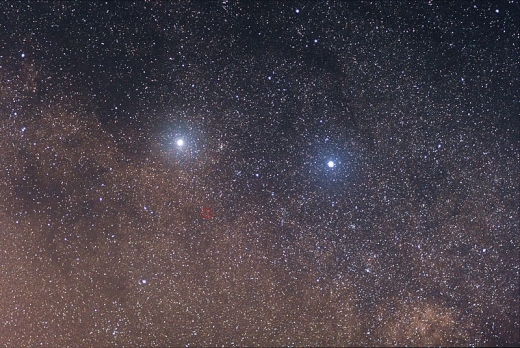
Image: The two bright stars are (left) Alpha Centauri and (right) Beta Centauri. The faint red star in the center of the red circle is Proxima Centauri. Here I always pause to remind people that Beta Centauri is an entirely different star, not part of Alpha Centauri. The stars we know as Centauri A and B are both within the glare of what appears to be the single ‘star’ on the left. The star Beta Centauri is actually in the range of 400 light years from us — don’t confuse it with Centauri B. This image was taken with a Canon 85mm f/1.8 lens with 11 frames stacked, each frame exposed 30 seconds. Credit: Skatebiker at English Wikipedia.
Radial velocity work, looking for the faint back-and-forth motion of a star as it is affected by the gravitational forces of orbiting planets, demands patient and time-consuming analysis. Fischer, Zhao and colleagues used more than a decade of radial velocity measurements for Centauri A and B as well as Proxima, drawing on CHIRON, UVES and HARPS data and using simulated signals to assess the probability that the signal could have been produced by stellar noise alone. The paper shows the lengths to which they went to screen for systematic errors as well.
This gets intriguing, for we know that with radial velocity, a key issue is that we cannot obtain a true planetary mass, but rather a range of masses with a minimum established — this is the result of the fact that in most cases, we cannot know the inclination of the planetary system, so what might appear to be a relatively small planet at minimum could also be much larger.
At Alpha Centauri, though, other factors come into play. Here, the dynamical influences of the binary system mean, according to Zhao and Fischer, that any stable planets are most likely co-planar, or nearly so, with the 79 degree inclination of the stellar binary system. In that case we can derive from radial velocity data a figure that is approximately the actual planet mass for any planets we do find around Centauri A and B. The work demonstrates that terrestrial class worlds could still exist around Centauri A or B and would not have been detected by the past ten years of precision radial velocity searches. The idea that we could find Earth-sized planets using radial velocity methods is still robust, and that includes for searches inside the habitable zone.
Here are the specifics of the result:
At each point in the parameter space of M sin i and orbital period, we sample a Keplerian signal at the actual time of the observations with added white noise scaled to the errors to provide a baseline of planet detection space. These simulations exclude planets within the conservative habitable zone of each planet with a M sin i of greater than 53 M⊕ for α Cen A, 8.4 M⊕ for α Cen B, and 0.47 M⊕ for Proxima Centauri on average. This result for α Cen B comes from the HARPS data set; the CHIRON data set excludes planets in the habitable zone of α Cen B to greater than 23.5 M⊕.
Note that finding on Proxima Centauri, which tells us that there could be planets orbiting there that are less than one-half of Earth’s mass. We have a great deal to learn about planet possibilities around all three stars. Note, too, how this work picks up another theme we’ve looked at recently, the use of existing datasets to draw new conclusions. As to future work, the paper gives us the roadmap: We will need radial velocity precision in the 10 centimeters per second space before we can detect the smaller planets that may lurk around Centauri A and B.
ESPRESSO, anyone?
Bear in mind that work on Centauri A and B is currently tricky thanks to the small separation of the two stars as seen from Earth. That angular separation is now increasing, and the authors believe that the two stars will be ‘ideal targets’ for renewed radial velocity study by 2019. Adds Fischer: “The precision of our instruments hasn’t been good enough, until now.”
The paper is Zhao et al., “Planet Detectability in the Alpha Centauri System,” The Astronomical Journal Vol. 155, No. 1 (18 December 2017). Abstract / preprint.






December 18, 2017
GJ 436b: Polar Orbit May Flag Unseen Companion
Any thought that our Solar System offers a template for other stellar systems has pretty much vanished in the panoply of system architectures now exposed to our observation. But it seemed rational, in the days before we knew of the existence of other systems, to imagine that if they were there, they would be more or less well ordered. Planets presumably orbited in the equatorial plane of their star, all more or less co-planar (and if Pluto didn’t quite fit the bill, that was just more evidence of the features that would one day cause it to become a ‘dwarf planet’).
But looking at the eight planets that remained after Pluto’s ‘demotion,’ we see planets that are co-planar within about 7 degrees of difference. And as Ethan Siegel (Lewis & Clark College) points out, if we take Mercury out of the mix, the deviation from the plane is only about two degrees (Mercury’s inclination is 7 degrees). Likewise, planets in our system line up well with the Sun’s rotation axis. But some systems deviate far from this expected scenario.
This morning in Nature we learn more about the GJ 436 system, a red dwarf already in the public eye because GJ 436b, a transiting ‘hot Neptune,’ has an atmosphere that is evaporating, producing a cloud around the planet itself and a long tail — indeed, GJ 436 has been nicknamed ‘the hairy planet,’ one that evaporates like a comet.
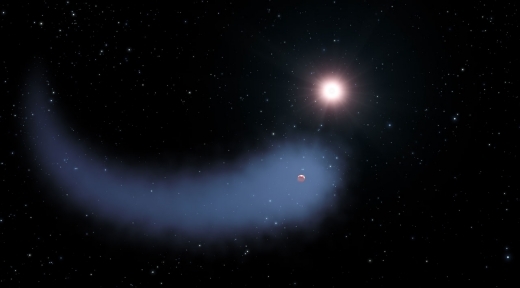
Image: This artist’s concept shows the enormous comet-like cloud of hydrogen bleeding off of the Neptune-sized planet GJ 436b just 30 light-years from Earth. Also depicted is the parent star, which is a faint red dwarf named GJ 436. The hydrogen is evaporating from the planet due to extreme radiation from the star. A phenomenon this large has never before been seen around any exoplanet. Credit: NASA, ESA, and G. Bacon (STScI).
This is a transiting world, so we have been able to determine both mass and radius — the planet is a bit more massive than Neptune, and about 5,000 kilometers larger in diameter. It orbits its host at some 4 million kilometers, fully 15 times closer than Mercury.
Now we learn that researchers at the University of Geneva (UNIGE) have determined that GJ 436b is in a polar orbit. In other words, rather than following in the equatorial plane, it passes above the poles of its star. Moreover, the orbit is eccentric to a degree that, given its proximity to the primary, is likewise unusual. UNIGE’s Vincent Bourrier is first author of the study:
“This planet is under enormous tidal forces because it is incredibly close to its star, barely 3% of the Earth-Sun distance. The star is a red dwarf whose lifespan is very long; the tidal forces it induces should have since circularized the orbit of the planet, but this is not the case!”

Image: A science fictional look at the GJ 436 system showing a stellar regatta. Space boaters parked in the equatorial plane of the star wait for the ‘hairy’ planet to emerge from this plane to “ride” the planetary wind with the help of kite-surfing vessels. As they rise above the poles of the star, they obtain a breathtaking view of the entire planetary system and can glimpse the mysterious disruptive planet, which appears as a bright spot in the background. Credit: Denis Bajram/UNIGE.
We’re reminded that the architecture of planetary systems preserves the history of their formation, if we can put together the clues. In this case, explaining an orbital scenario can itself become a tool for exoplanet discovery. For the new work ties in with earlier studies of a possible second planet, GJ 436c, around this star. The discovery was announced in 2008 but subsequently retracted, although the possibility of a second world here remained open.
The unusual orbit of GJ 436b now renders the presence of a more massive and distant second planet more likely. Planetary migration may be the cause of GJ 436b’s tight orbit. “Our next goal,” says Bourrier, “is to identify the mysterious planet that has upset this planetary system.”
Full citation when I have it. See also Bourrier et al., “An evaporating planet in the wind: Stellar wind interactions with the radiatively braked exosphere of GJ 436 b,” Astronomy & Astrophysics Vol. 591 (2016), A121 (full text).






December 14, 2017
Machine Learning: Potent Tool Discovers Two New Worlds
NASA’s news conference announcing the discovery of Kepler-90i and Kepler-80g was a delightful validation of a principle that has long fascinated me. We have such vast storehouses of astronomical data that finding the time for humans to mine them is deeply problematic. The application of machine learning via neural networks, as performed on Kepler data, shows what can be accomplished in digging out faint signals and hitherto undiscovered phenomena.
Specifically, we had known that Kepler-90 was a multi-planet system already, the existing tools — human analysis coupled with automated selection methods — having determined that there were seven planets there. Kepler-90i emerged as a very weak signal, and one that would not have made the initial cut using existing methods of analysis. When subjected to the machine learning algorithms developed by Google’s Christopher Shallue and Andrew Vanderburg (UT-Austin), the light curve of Kepler-90i as well as that of Kepler-80g could be identified.
Christopher Shallue described the work at the news conference:
“Kepler produced so much data that scientists couldn’t examine it all manually. The method has been to look at the strongest signals, examining them with human eyes and automated tests, not so different from looking for needles in a haystack. Out of 30,000 signals examined, 2500 planets could be confirmed. We chose to search in weaker signals, as if in a much bigger haystack.”
Machine learning shines in such situations, with the neural network able to identify planets with a far weaker signal that would have never made the initial cut for human analysis. In order to train the network, Shallue and Vanderburg fed it 15,000 Kepler signals that had already been labelled by human scientists, allowing it to learn by example to distinguish those patterns caused by planets. In their test runs, the model identified planets 96 percent of the time.
Shallue described the machine learning system as a neural network made up of layers that perform individual computations and pass them along to the next layer in the stack. Given enough layers, it becomes possible to recognize complex patterns, as we have seen in language translation, image and object identification, and the detection of tumors. Now we turn these methods to exoplanet detection in a discovery that bodes well for future discovery.
The two new planets were found through analysis of Kepler data on 670 stars, a major proof of concept for a method that will doubtless continue to improve, and one that will eventually be applied to the entire range of 150,000 stars in the Kepler and K2 dataset. That opens the possibility of numerous new planetary discoveries from the Kepler mission alone, not to mention what we will find with more advanced AI using the TESS and JWST datasets.
Andrew Vanderburg provides a bit more detail on the method at his CfA page:
Once we had built a neural network, we decided to test it out on some new signals. Using traditional transit-search methods (in particular, the same methods I use to search K2 data), we performed a new search of a handful of systems observed by Kepler (in particular, about 670 systems known already to host multiple planets). Importantly, we allowed this search to very sensitively explore weak signals. Usually, when searching Kepler data, a threshold in signal strength is set, below which weak signals are discarded, so as not to overwhelm the searcher with false positive signals. By lowering this threshold in our new search, we suspected that we might find some new planets, at the expense of a large increase in the number of false positives. But because we have a neural network that can efficiently identify real planets and screen out false positives, we could still efficiently identify new planets.
As to the planets themselves, Kepler-90i, orbiting a G-class star somewhat larger and more massive than the Sun some 2500 light years away, is interesting because it turns the Kepler-90 system into the closest thing we have to a Solar System analog, at least in terms of the number of planets. But the resemblance is hardly complete, for these planets exist in a highly compact system. Have a look at the orbital configuration here.
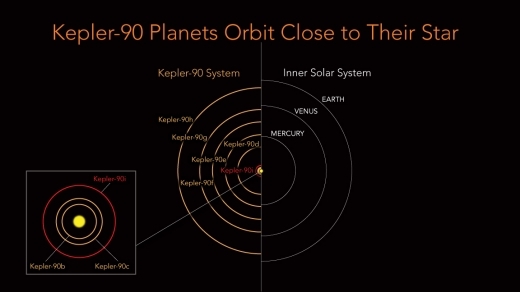
Image: Kepler-90 is a Sun-like star, but all of its eight planets are scrunched into the equivalent distance of Earth to the Sun. The inner planets have extremely tight orbits with a “year” on Kepler-90i lasting only 14.4 days. In comparison, Mercury’s orbit is 88 days. Consequently, Kepler-90i has an average surface temperature of 800 degrees F. Credit: NASA.
The image below shows an artist’s concept of the planets in question, though the distances are obviously not to scale. The planet sizes, however, are.
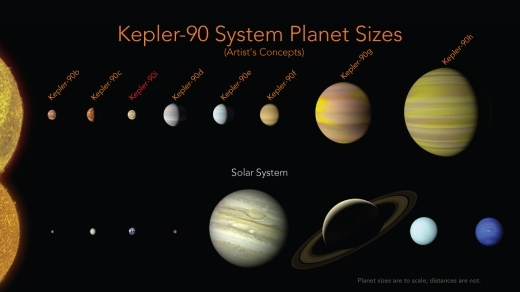
Image: The Kepler-90 planets have a similar configuration to our solar system with small planets found orbiting close to their star, and the larger planets found farther away. Credit: NASA.
Kepler-80g has an orbital period close to that of Kepler-90i, about 14 days, and is the 6th planet in its system, which has a host star that is either a late K-dwarf or an early M-dwarf. Here we find the already discovered five planets orbiting in a resonance chain, with mutual gravitational interactions keep their orbits aligned. As Andrew Vanderburg pointed out, the orbital period of the new planet could have been predicted based on the mathematical relations of this resonance, within about two minutes of the actual measure.
It was heartening to hear at the news conference that the training model used in these detections will be made publicly available. According to Google’s Shallue, about two hours suffice to train the model on a desktop computer using open source machine learning software called TensorFlow, which is produced by Google. When the code becomes available, anyone will be able to use the model on the publicly available Kepler data on their own PCs.
The paper is Shallue & Vanderburg, “Identifying Exoplanets with Deep Learning: A Five Planet Resonant Chain around Kepler-80 and an Eighth Planet around Kepler-90,” accepted for publication in The Astronomical Journal, and for now available here.






Paul Gilster's Blog
- Paul Gilster's profile
- 7 followers




